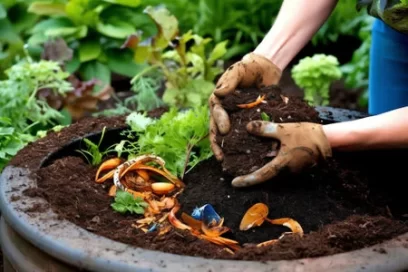- You have no items in your shopping cart
- Subtotal: ₹0.00
Gardening is one of the most amazing stress busting activities. It helps us to connect with the Mother Nature, and most importantly with ourselves. It is not less than meditating in the woods, trying to connect with our inner self. To ensure the activity remains fruitful, you must include vermicompost in your gardening to-do list. This article will help you understand how you can use vermicompost for your garden so that the plant will get more nutrients and ultimately you can get more benefits.
For Potted Plants
There are a few easy measures to take when utilizing vermicompost in potted plants. The potting soil should first be mixed with vermicompost at a ratio of 1 part vermicompost to 3 parts dirt. Your plants will receive a consistent supply of nutrients from this mixture, which will encourage strong growth.
Depending on the size and type of the plant, different plants require different amounts of vermicompost. For small to medium-sized plants, you should use about 100 grams of vermicompost, or 200 grams for bigger plants. Adapt the dosage to the particular requirements of your plants.

For Indoor Plants
In addition to helping outside gardens, vermicompost can also be utilized to feed indoor plants. When transplanting your indoor plants, just add the necessary quantity of vermicompost to the potting mixture. This will increase their intake of vital nutrients and support their growth into strong, healthy adults.
As Top Dressing
Top dressing, as the name suggests, is the process of applying worm compost directly on top of the soil. Once more, it doesn’t require much at all. Even a light sprinkle will eventually filter down and feed the plant if it is placed over the root mass. Given that it doesn’t need measuring or mixing, this is the simplest technique to integrate vermicompost.
Seed Starter
Any gardener who takes the time to raise plants from seed will know that they need gentle handling, ideal light exposure, water, and nutrients to develop past that initial stage. But by adding a healthy amount of vermicompost in proportion to the other ingredients in your seed starting mixture, you increase the likelihood that the tiny seedling will not only survive but also thrive.
As a Liquid Fertilizer
The liquid fertilizer known as compost tea is created by steeping finished vermicompost rather than tea leaves, despite the misleading term that initially makes you think of chamomile or anything like. Beneficial bacteria multiply in the water over time, producing a tonic that can be sprayed ON the plants to protect them against things like airborne diseases and infestation in addition to fast delivering nutrients directly to the roots.
Fertilizer Uses in Your Garden
You can employ vermicompost into your garden by top-dressing the soil or mixing it in with the existing soil. This will help improve soil fertility and structure, allowing your plants to better absorb water and nutrients. It can be used with various types of plants, including vegetables, fruits, and flowers.
It is obvious that individuals who use black gold worm compost to grow wholesome vegetables, beautiful landscape plants, or even stellar houseplants consider it to be nothing less than a treasure. However, there is still another way that finished compost supports soil that is vital to life.
Read More: Advantages Of Vermicomposting
